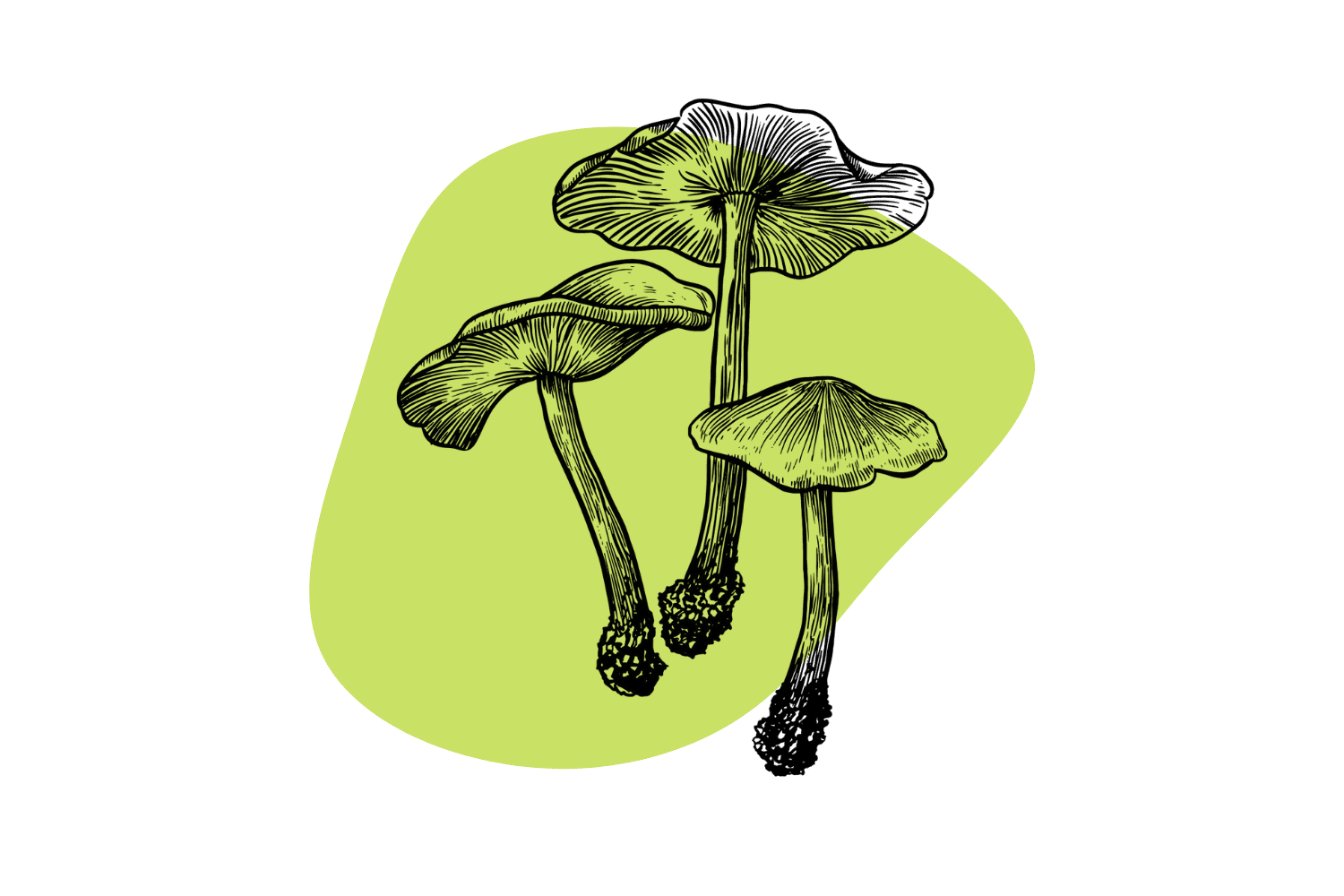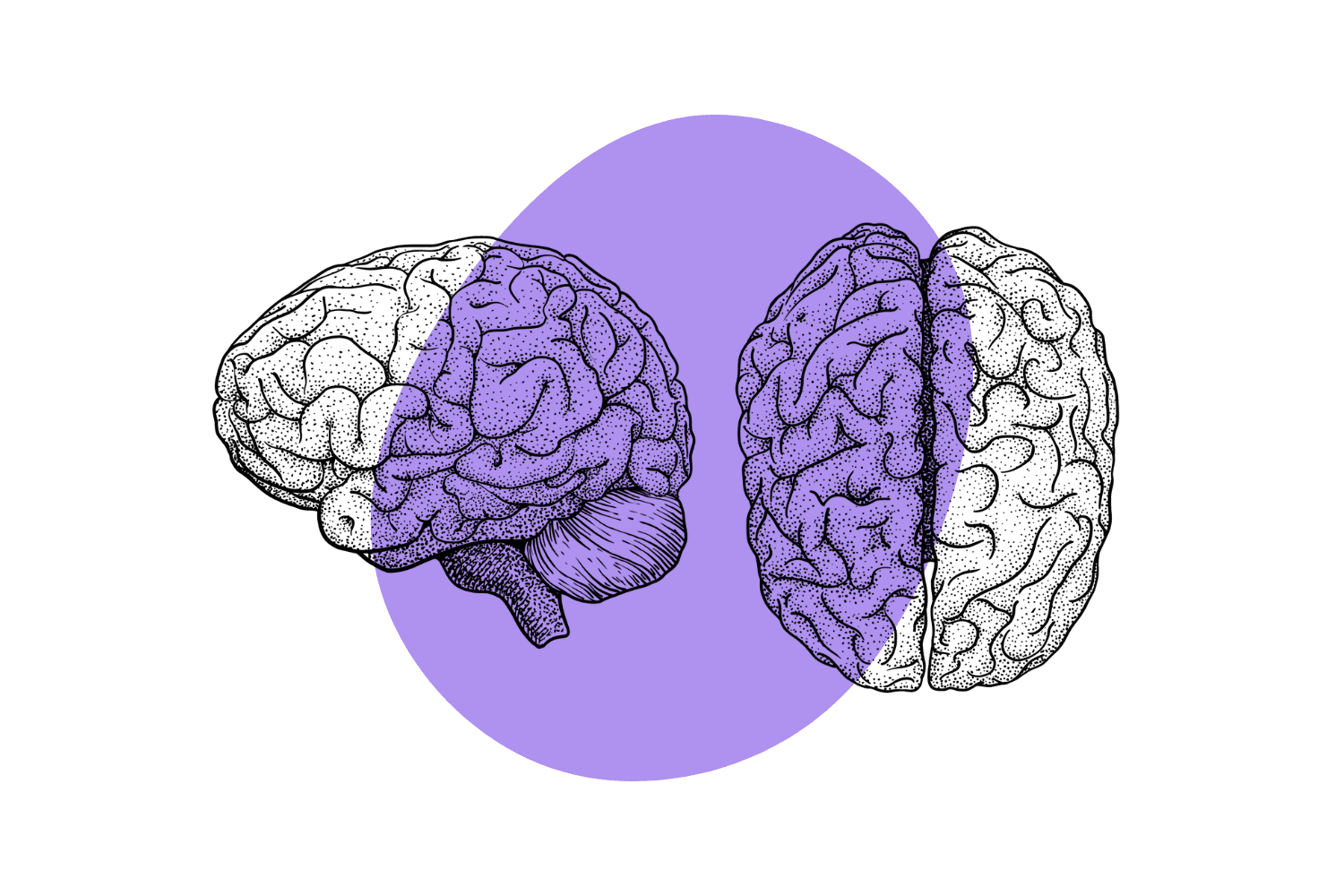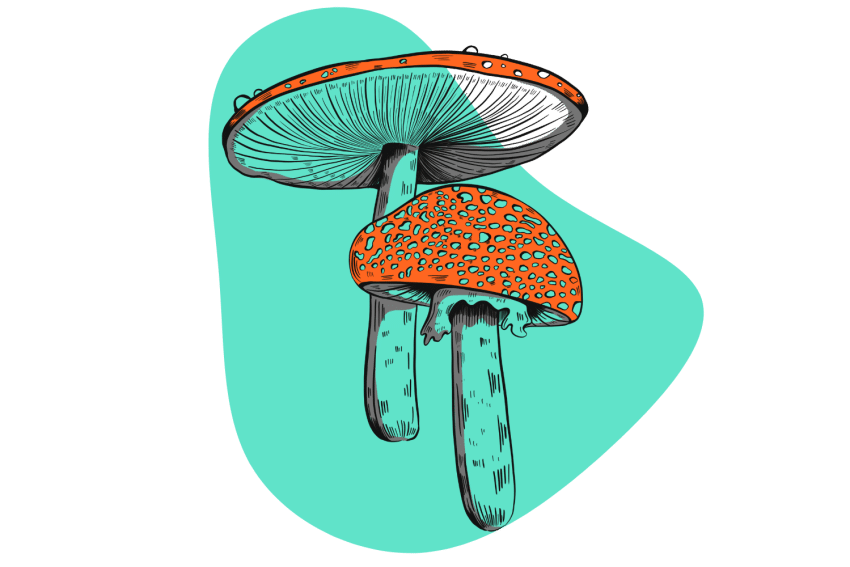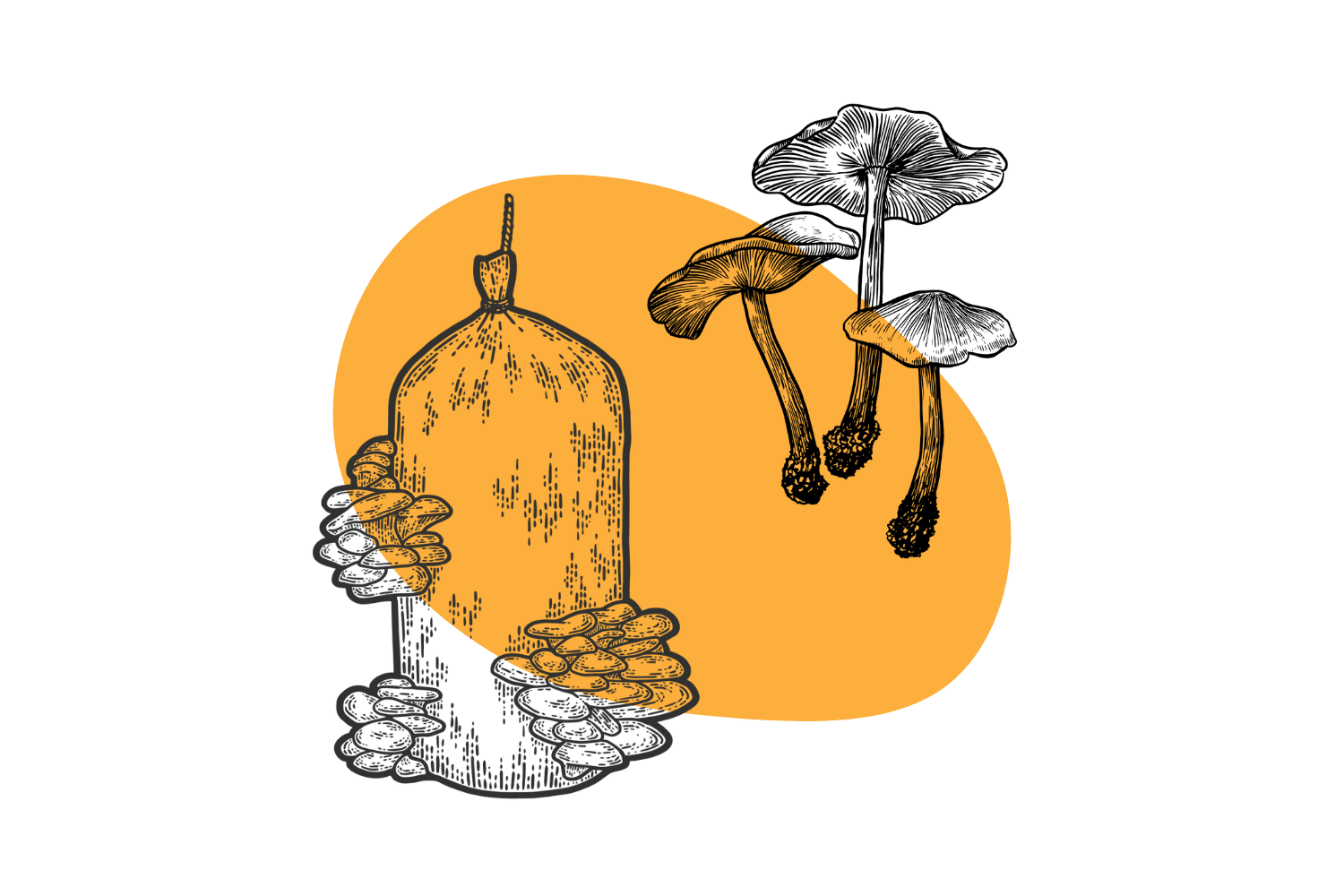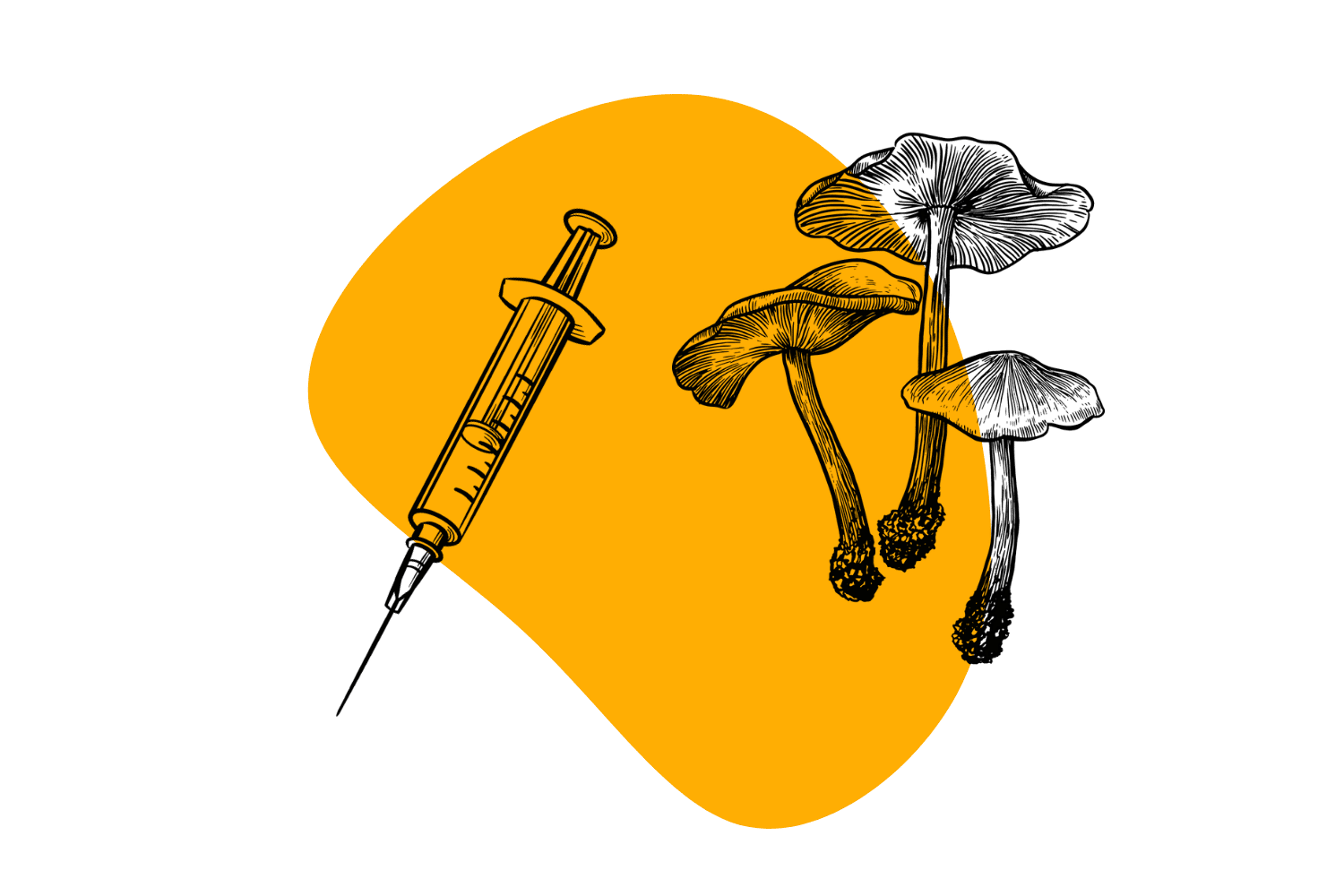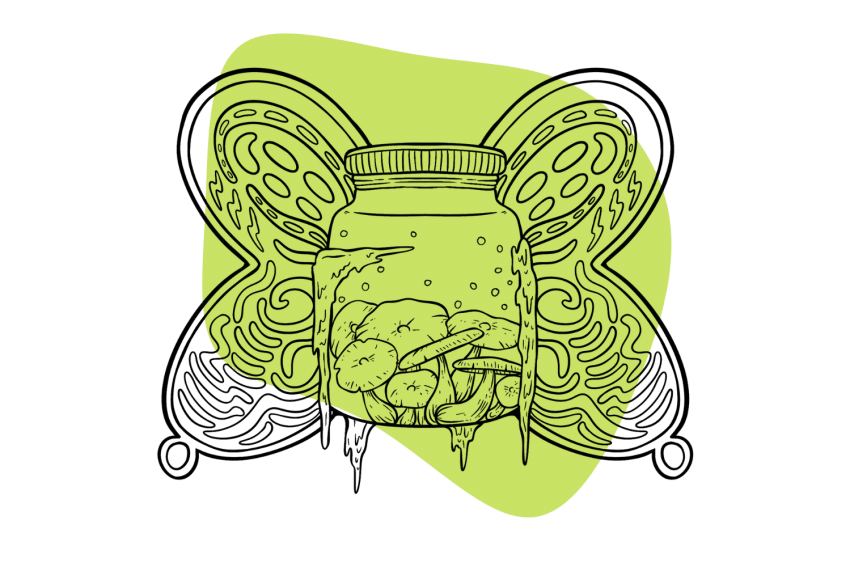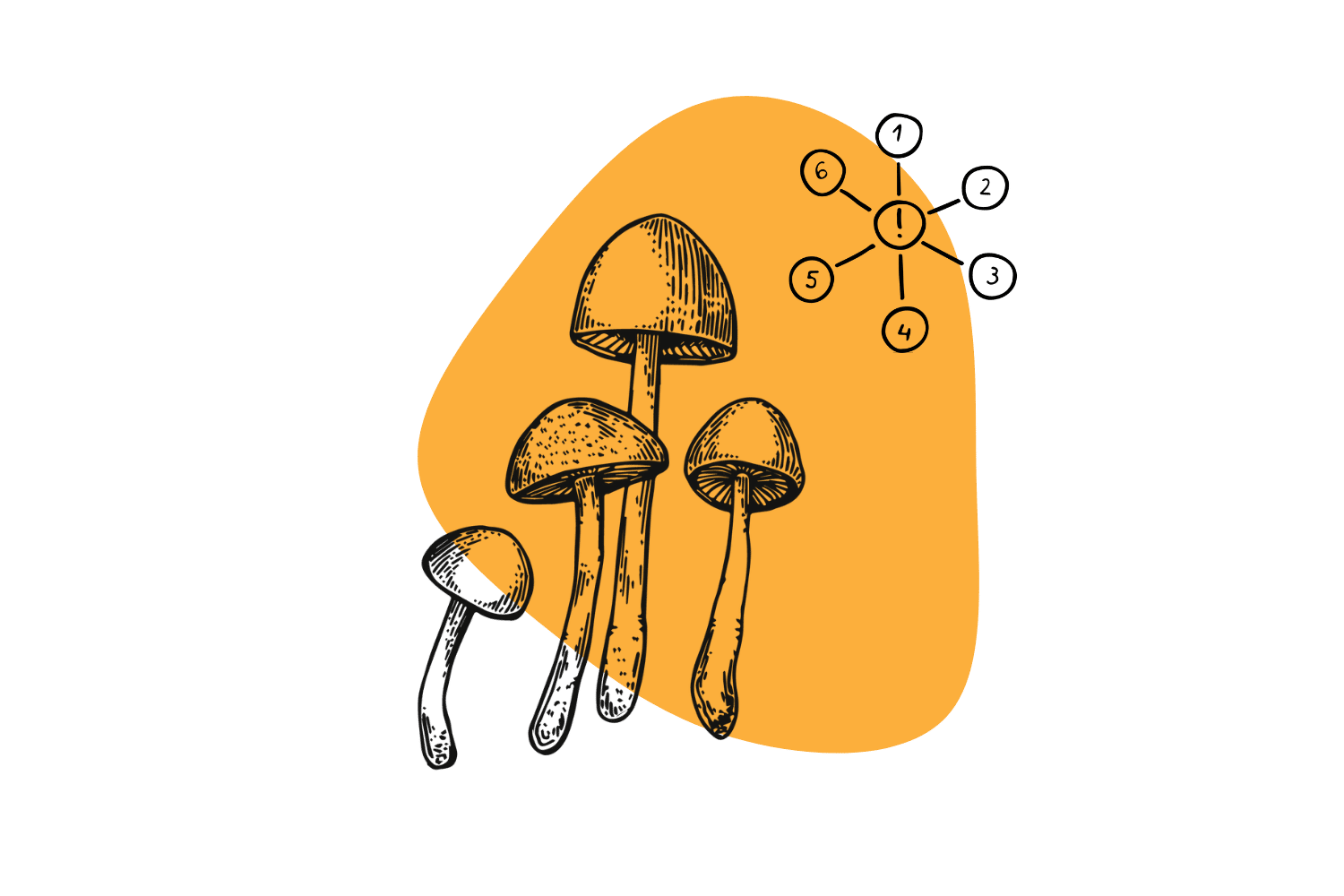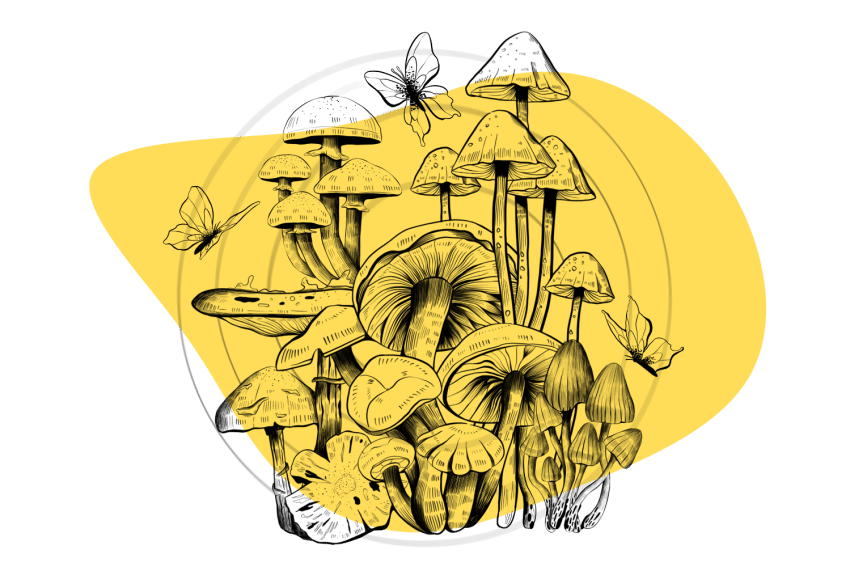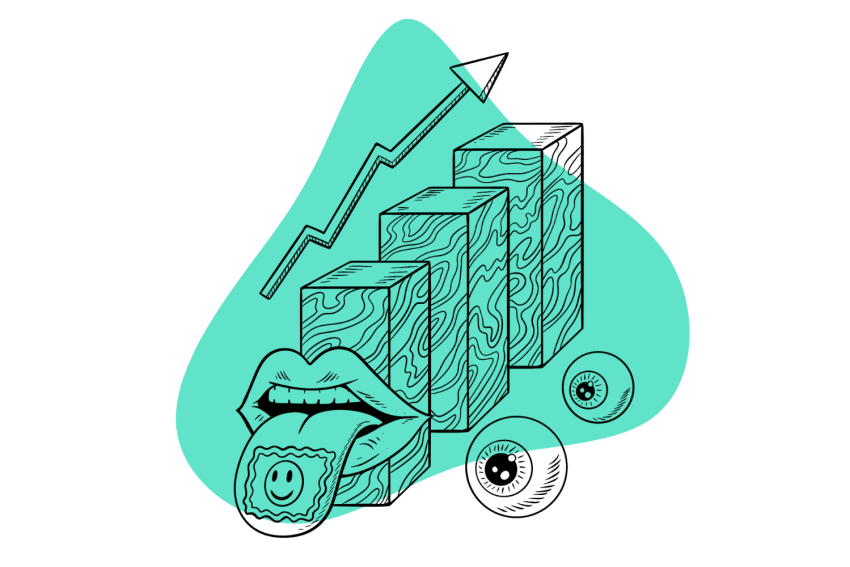Magic Mushrooms vs. LSD: Key Similarities & Differences Explained
Take magic mushrooms to look inward and LSD to look outward. LSD lasts longer and has a more clear-headedness than magic mushrooms. Both produce similar visual effects.
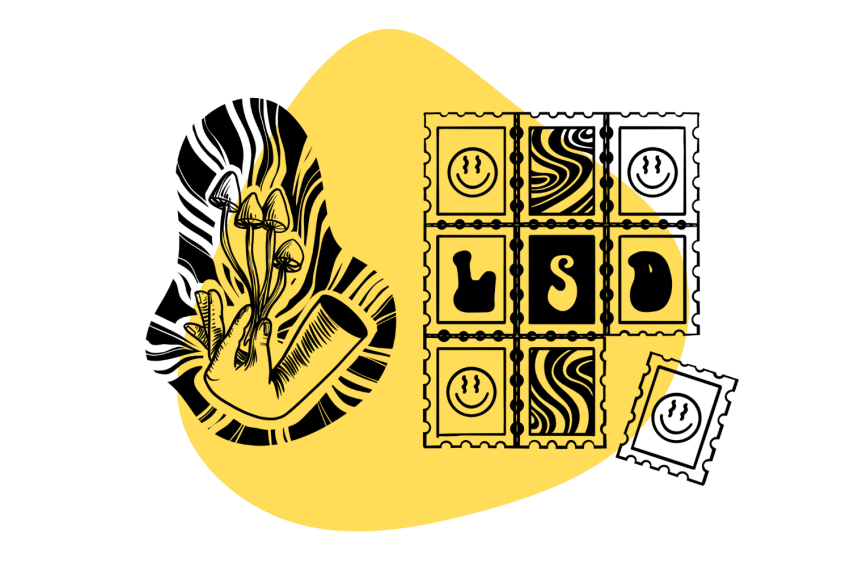
There are three primary differences between magic mushrooms and lysergic acid diethylamide (LSD):
- Duration of action — LSD lasts roughly 1.5–2x longer than magic mushrooms
- Quality of effects — LSD tends to be more clear-headed, while mushrooms are more introspective
- Source/origins — magic mushrooms are naturally occurring; LSD is a semi-synthetic molecule obtained from Claviceps fungus
These are the major differences between them, but there are, of course, other differences to keep in mind too — which we’ll cover in detail throughout this article.
Here’s how magic mushrooms and LSD stack up side-by-side:
| Magic Mushrooms | LSD | |
| Production | Grows naturally | Synthetic |
| Threshold Dose | 1g dried mushroom (10 mg, Psilocybin 5mg, Psilocin) | ~80 μg |
| Typical timeline | 0–1h: Onset/Comeup 1–3h: Peak 3–4h: Fading Effect 4–6h: Comedown 5–7h: Return to baseline | 0–1.5h: Onset/Comeup 1.5–3h: Peak 3–6h: Gradual fade 6–10h: Comedown 8–12h: Return to baseline |
| Safety Profile | Very safe, low risk of contamination | Very safe, moderate risk of contamination |
| Most Common Format | Fresh or dried mushrooms | Liquid on blotter paper, powder, gelatin tabs, pills |
| Route of Administration | Oral | Sublingual |
| Site of Activity | Serotonergic receptors. Mainly 5-HT2A and 5-HT1A but also 5-HT1D and 5-HT2C [1] | The same serotonergic receptors along with the dopaminergic D1–3 receptors and adrenergic α1 receptors [2] |
| Reported Physiological Effects | Frequent nausea and gastrointestinal distress, heavy body load, physical disorientation, cold sweats | Less heavy physiological effects with body temperature fluctuation, cold sweats, and elevated heart rate/blood pressure |
| Common Setting For Use | Isolation or with a group of people you trust. | Introspective settings as well along with select social settings like concerts or gatherings |
| Reported Psychedelic Effect | Heavy body load with introspective thoughts and deep connection to nature and others | A cerebral sensation that lends itself to introspection but with a light enough effect on the body for those who want to get up, move around, dance, or have fun with others |
What’s the Difference Between Magic Mushrooms & LSD
Research is scarce but mostly points to LSD’s lengthy duration of effect as the only difference between the two drugs [3]. Psychonauts largely — almost uniformly — refer to LSD as more “cerebral” and/or social compared to magic mushrooms.
Importantly, the study uses a pill form of pure psilocybin instead of whole mushrooms. While this is great for blinding and dose control, it doesn’t show us the whole story.
Here are some of the ways these two drugs may be drastically different:
Perceptual Differences Between LSD & Magic Mushrooms
Even the source of the substance could fundamentally shift our relationship with it. Mushrooms — naturally occurring with an ancient history from cultures thousands of years ago — could make us feel more connected to the earth and humanity simply because we know they came from there, and generations of humans took it.
LSD’s shorter history and synthetic nature could, conversely, make us feel more cerebral and analytical because we don’t feel drawn to the earth in the same way. Instead, our subconscious may connect it with analytical research and excitedly tinker away at a profound problem.
The vast majority of people take psychedelics from home in their typical forms. These biases may be unavoidable. Research may also one day discover a real connection between the differing pharmacology of the two substances and their effects as well.
We have no way of knowing without proper, dedicated research.
Pharmacological Differences in LSD & Magic Mushrooms
While these two drugs act similarly and we don’t have extensive levels of research, we do know some big differences in how these drugs act. Their main action — the
Magic mushrooms may contain varying potentials of up to 140 potentially active components we know of so far [4]. Few of them have any research behind them, and it’s unlikely we’ll discover one is a secret star of the show, but they could all contribute to the experience.
Magic mushrooms’ weight is often under 1% psilocybin and even less for psilocin — cannabis THC content can be 30% or more of the flower’s weight. A large remainder of the amount is water, but the rest consists of additional alkaloids, chemicals, and compounds which may contribute to the effect in small or meaningful ways.
Magic Mushroom Components
The main compounds people discuss for magic mushrooms are psilocin and its prodrug psilocybin. Both of these represent alkaloids — natural compounds capable of profound effects on humans — and they aren’t the only ones. Nor are they the only potentially active component of the mushroom.
Here are some of the other candidates for the distinct activity of magic mushrooms:
- Other Alkaloids — Namely, “baeocystin, norbaeocystin, and aeruginascin are tryptamines structurally similar to the neurotransmitter serotonin” are of interest [5]. Though typically only present in trace amounts, they could bolster, alter, and impact the psychedelic experience in ways we don’t understand.
- Concentrations — Differing strains, batches, and storage methods can all lead to non-standardized concentrations of active components. Mushrooms produce these in varying concentrations for reasons we don’t understand, along with many other factors making varying them greatly.
- Beta-Carbolines — The impact these have on inhibiting our monoamine oxidase enzyme (MAO), which breaks down drugs and other molecules, may be huge. Also important for ayahuasca, some also like to add an MAO inhibitor with mushrooms (or psilohuasca) and claim it potentiates the effect. It seems the mushroom does some of this on its own as well, though its effect is unsure [6].
- Others — Zorilla and Evidente identified “114 new compounds with different structures” researchers had discovered since 2002. They also add “most of which are activities of pharmacological interest, such as antioxidant, anti-inflammatory, neuroprotective, antibacterial, and enzyme inhibition properties [4].”
We know very little about any of these elements and truly are in the beginning stages of research, even on psilocybin and psilocin. It’s possible — like cannabis’ “entourage effect” [7] — the culmination of these compounds and their variations represent the perceived differences users experience.
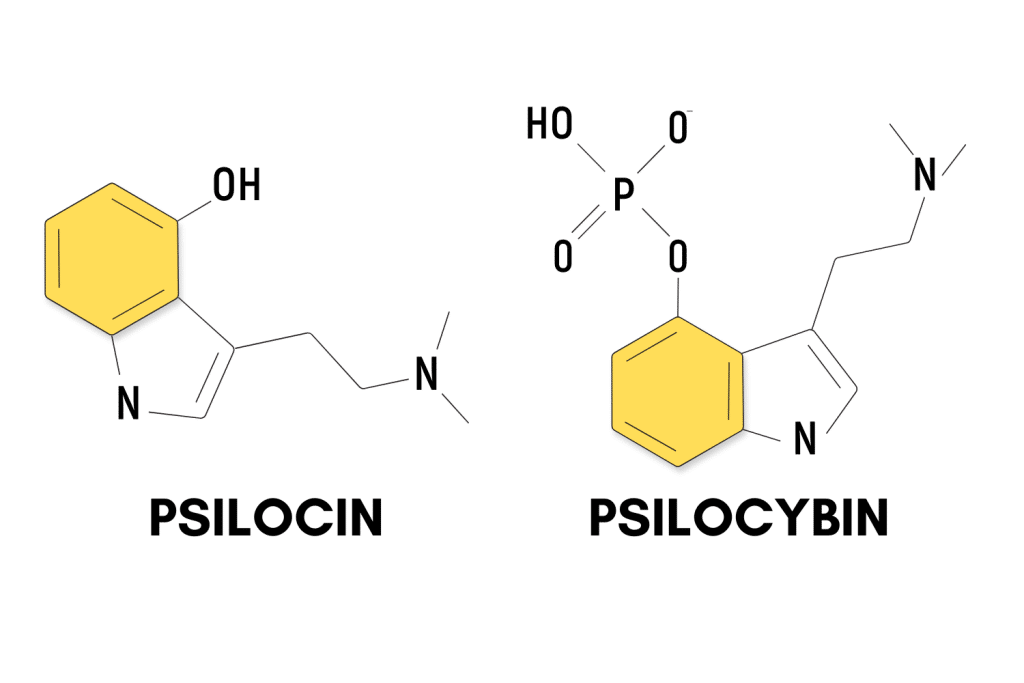
LSD’s Increased Affinity & “Lid” Mechanism
LSD doesn’t have an entourage effect since producers create the drug synthetically, but its unique molecular structure still sets it apart from isolated psilocybin. Molecularly, LSD contains the entire serotonin molecule with two ring structures locking the normally free-moving arm in place.
Not only does this provide it with a more rigid structure, but recent evidence also suggests another mechanism contributes to the longer-lasting nature of LSD. Researchers obtained a crystal structure image of LSD bound to a 5HT2B receptor and discovered a potentially incredible reason for its lengthy activity.
Unlike serotonin which sits on top of the cell, LSD and other psychedelics seem to activate receptors within [8]. Having obtained a crystalized image during binding, researchers now believe LSD effectively closes and locks the door behind it [9].
After binding, byproducts of the activity of doing so act “as a latch, reducing the mobility of the lid and constraining LSD’s access to and egress from the binding pocket.” Psilocin likely similarly enters the receptor and may even lock the lid shut as LSD does, but it still has a free-moving arm which might make it less stable.
Our images with LSD are the only ones we’ve done so far, so it’s possible we’ll discover this is common among the class of substances. Molecularly speaking. However, we have rarely topped LSD in terms of potency and have never beaten it when it comes to potency and safety.
Roughly 1% of the baseline amount for magic mushrooms is a full trip on LSD, and its amazing structure likely lends itself to this.
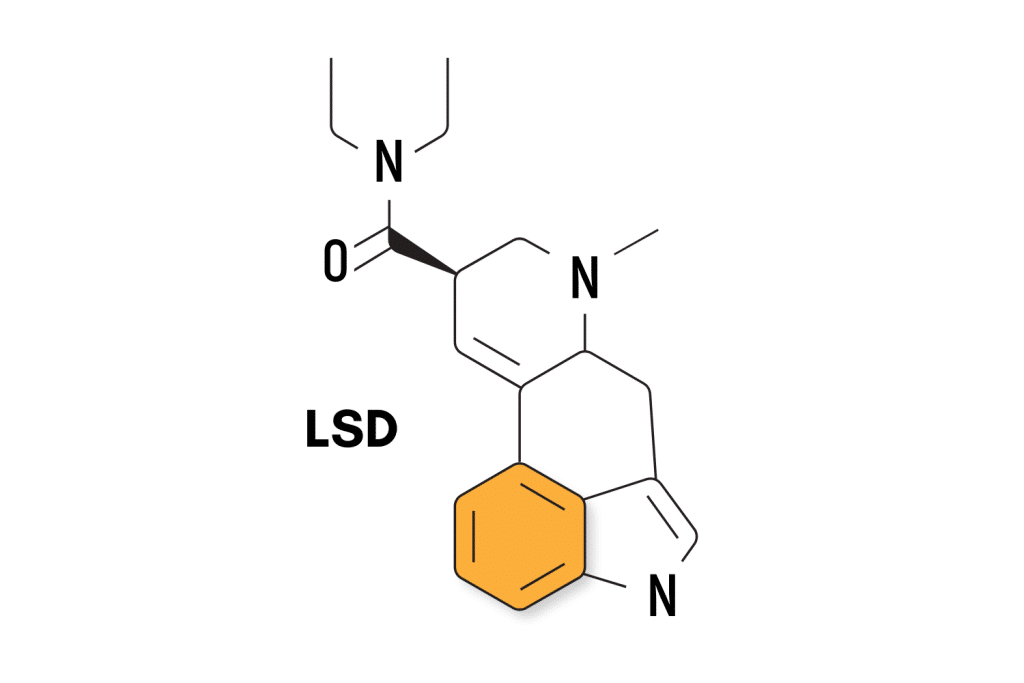
Different Effects of Magic Mushrooms vs. LSD
The main difference between the two came down to the duration of the effect — LSD lasts longer than psilocybin. Several psychonauts report this is not the case, however, often swearing by differing “personalities” or “lessons” from the two substances.
The only study evaluating their different effects used an isolated form of psilocybin but found people could not effectively guess which group they were in (break blind.) While low doses of psilocybin were rarely confused with LSD and the low dose of LSD was rarely confused with psilocybin, the high doses were indistinguishable [3].
This remains true even at the end of the study, although the only scientifically provable difference between the two is the duration of effect. As the study puts it:
This was still the case at the end of the study, despite the clear differences in effect durations between LSD and psilocybin that could be expected to unmask the blinding between the substances … Alterations of states of consciousness that are induced by LSD and psilocybin are more likely dose-dependent rather than substance dependent
So, what about those people who claim LSD is more “cerebral” or less “body heavy?” Are they all just experiencing a placebo effect based on trip reports from years gone by?
A pill containing psilocybin is a far way off from the full contents of a psilocybin-containing mushroom. The mentality around taking it aside — never underestimate the power of your expectations — researchers are still removing over 100 potentially important compounds.
LSD may have the “cerebral” effect, and psilocybin is more “introspective,” as psychonauts suggest. Even the elevation of nausea can drastically affect the experience, adding an initiation component to mushrooms users don’t necessarily have on LSD.
Are Magic Mushrooms Harsher than LSD?
Dried mushrooms are inherently harsher on the stomach to consume than a drop of liquid on blotter paper. All psychedelics can lead to cold sweats, body temperature fluctuations, nausea, anxiety, and more — many feel magic mushrooms do this more than LSD.
While the primary receptors psychedelics interact with are in the central nervous system (CNS,) these same receptors influence the gastrointestinal (GI) tract [10]. No qualitative studies currently exist to say whether — or why — mushrooms might be harsher than LSD on the GI tract.
Potential (unconfirmed) explanations include:
Alkaloidal Contents
By sheer virtue of not requiring you to eat several mushrooms, LSD is likely easier on the stomach. However, if we were to put pure psilocybin up against LSD, the picture would get murkier.
Other alkaloids within the mushroom could make the bodily effect more unpleasant. While increased levels of serotonin seem to play a role in irritable bowel syndrome (IBS) [10], we don’t know if serotonergic drugs do the same.
If they do, the range of alkaloids present in mushrooms could work together to make the experience more unpleasant. We know little about baeocystin, norbaeocystin, and aeruginascin, but they are all tryptamines and have a good chance of carrying some form of activity.
Perhaps, the bulk of this activity rests in the gut, and this is why pure psilocybin was indistinguishable, but psychonauts swear by a difference. LSD causes some nausea as well, so it’s likely to interact with the same receptors, but more chemicals might lead to more of an effect with mushrooms.
Does LSD Better Target Receptors in the Brain?
The higher affinity LSD has for receptors could theoretically translate into less of it interfering with the receptors in the gut. Psilocybin typically starts from the gut and works its way into the bloodstream since users eat it orally, so it may hit more GI receptors than LSD does.
Additionally, some of the tryptamine alkaloids in mushrooms may target those receptors specifically for all we know. Norpsilocin, for example, has a higher affinity for 5-HT2A receptors than psilocin and likely doesn’t cross the crucial blood-brain barrier [11].
We have a limited understanding of the way any alkaloid works. It’s possible nor-psilocin degrades, metabolizes, or otherwise disappears at this point, OR maybe it sticks around a bit and winds up in the gut to wreak havoc.
There may even be some bigger, unconsidered element at play. Without fundamental updates to the way we fund research, this question will likely stay unanswered for some time.
Safety: LSD vs. Magic Mushrooms
Comparing these substances side-by-side reveals very few differences when it comes to safety. LSD and magic mushrooms are both incredibly safe drugs, but the synthetic nature of LSD makes the risk of contamination higher for it. It’s important to always test your LSD before partaking to make sure the contents match the label.
Mushrooms grow easily inside people’s homes or in outdoor environments, but LSD requires complex chemical reactions and prohibited precursors. Though not as frequent as other drugs, it’s not uncommon for LSD from the street to contain other compounds.
Consequences of this could range from an inactive piece of blotter paper to a more dangerous substitution. In particular, the occasional replacement of LSD with 25I-NBOMe — a synthetic hallucinogen with deadly side effects — is of concern.
There’s very little profit in trying to replace mushrooms with any other drug or contaminant. While both have encouraging safety profiles, the risk of contamination and misrepresentation of drug contents makes LSD slightly more dangerous.
Of course, these are problems of prohibition — if it weren’t hard to find the components of LSD (or the drug itself), this concern would vanish.
Mental & Physical Risks of LSD & Magic Mushrooms
While they are non-toxic and largely safe in any dose, this doesn’t mean there aren’t potential consequences of using psychedelics. In general, the concerns around drugs like LSD and psilocybin center around your physical safety while inebriated and the emotional burden of a horrifically bad trip.
The former concern receives more attention than it’s due in the media — with sensational stories of people “thinking they can fly” or other tall tales — but still deserves respect. Psychedelics remove us from our ability to make sound decisions, and this can occasionally lead to disastrous circumstances.
Whenever planning a psychedelic experience, make sure you have someone nearby you trust who is sober and there to keep you safe. You shouldn’t be the ultimate authority on what is and isn’t a good choice — ask someone you trust to help step in and let you know when psychedelics might be leading you to a bad decision.
As for the emotional and mental concerns of psychedelics, a “bad trip” is no laughing matter. In extreme circumstances, these could leave users with PTSD [12] or exacerbate the very concerns they sought help from the drug for.
Whenever looking to use psychedelics to address an important mental health concern, a clinician should always be present. For everyday consumers, it can still be nice to have a therapist nearby, but you should at least still ensure your trip sitter knows how to guide you through a negative experience.
These and other basic guidelines can tremendously lower the risks associated with using psychedelics.
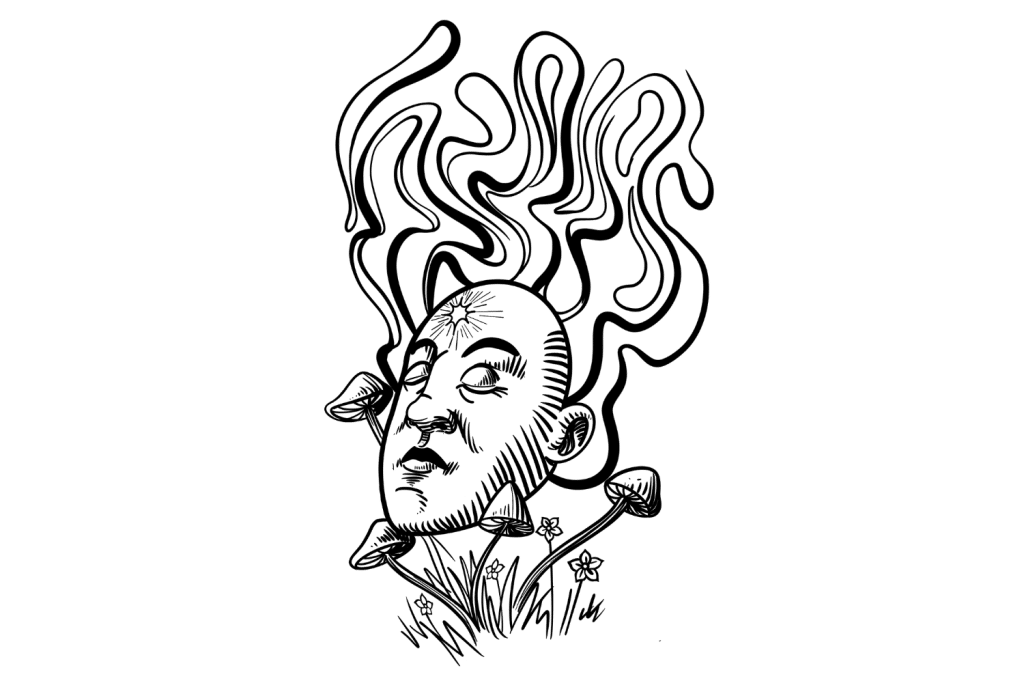
Which is Better: LSD or Magic Mushrooms?
Each psychonaut has a preference between the two and often determine which to reach for based on the setting and desired experience. Whether the reasoning for their different effect is psychological or pharmacological is uncertain, but reports are often similar.
The belief, generally speaking, is mushrooms tend to have higher levels of introspection and LSD to a more “cerebral” experience. “Cerebral” in this sense doesn’t mean it can’t be introspective, but, rather, many feel it doesn’t have to be. Conversely, the perception of mushrooms revolves around it, making you look inward whether you want to or not.
When is LSD a Better Choice than Magic Mushrooms?
From a research standpoint, LSD is best when you want a longer psychedelic trip with fewer physical side effects. Additionally — according to people “in the field” using them — LSD is better for a cerebral effect without as much introspection as you might expect from magic mushrooms.
While LSD — along with all other psychedelics — is still deeply introspective, it typically carries fewer physical side effects. As a result, most people don’t feel as stuck to the couch as they often do with magic mushrooms.
Moving around is easier, and people often enjoy spending time with friends, going to concerts, watching trippy movies, and other sociable activities. This might mean kicking back and watching 2001: A Space Odyssey or attending a Phish concert, or spending a fun night with a loved one.
Just avoid spending time around people who are drinking a lot. Trust us; you don’t want to see someone blackout drunk while tripping on acid.
The most important thing is making sure you comfortably and safely have enough time for the experience and a healthy mindset and understanding going into it.
When are Magic Mushrooms Better than LSD?
Mushrooms may be better for a time when you want an introspective experience and want to get back to baseline sooner to start integrating the experience. While they don’t last as long as LSD, you’ll still want to block out the entire day.
Psychonauts don’t always want to dedicate 10–12 hours to tripping — even if they don’t have plans later. With many feeling magic mushrooms are better for introspection, nature-connectedness, and empathetic feelings, the return to baseline is often welcomed by users who are ready to begin processing everything.
The ideal settings for mushroom trips for most are in a clean room without many people around and a dedicated trip sitter. Diving deeper into your mind can bring up dark thought patterns and memories, and it’s important to trust yourself and those around you and a safe, healthy environment.
Can You Combine Magic Mushrooms & LSD?
Combining magic mushrooms and LSD — or “Soul Bombing” — is relatively common among psychonauts. While the combination is likely safe, enhancing the experience can feel overwhelming and worsen bad trips in the same way it potentiates good ones.
Still, many enjoy the combination and find the effects complement each other and create a different feel. There are several ways to soul bomb, but the consensus seems to be taking LSD first and then the mushrooms 30–60 minutes later is the best approach.
This enables the peak of both drugs to hit around the same time, with the LSD lasting through the comedown from mushrooms. Of course, each person is different and may enjoy a different order or timeline, but it’s important to consume both within about two hours.
Cross-tolerance between LSD and psilocybin builds quickly, and waiting longer may diminish the efficacy of the second drug.
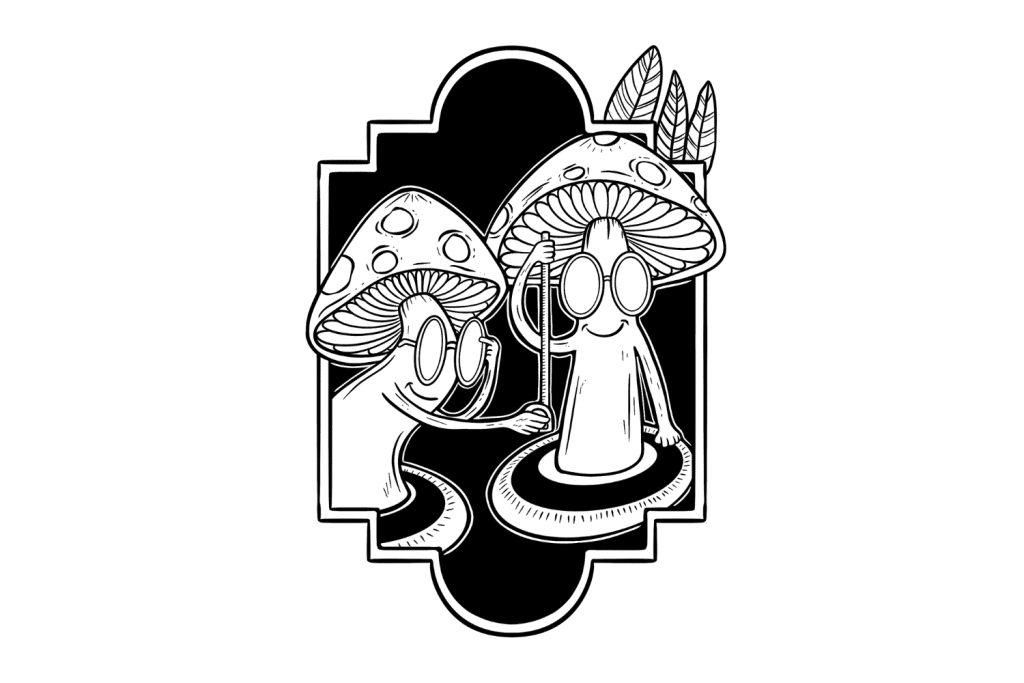
Final Thoughts: Should I Try Mushrooms or LSD?
Both, if you want to! Both are potent psychedelic drugs with safe profiles, consistently impactful experiences, and therapeutic potential. The main difference is LSD’s longer time of activity and the dried mushroom material, additional alkaloids, and physical side-effects of magic mushrooms.
Whether you reach for one or the other depends on personal preference and desired timeframe above all else. Research is notoriously underfunded for exploratory studies like these since they often don’t have much of a financial implication.
While there are speculations for the reasoning behind the different physical effects of these drugs, none have research behind them. Psychonauts frequently reach for acid and magic mushrooms at different times for various desires.
Generally speaking, much of the internet agrees on the circumstances which call for LSD, psilocybin, or both. Whether each substance acts differently or we ascribe these meanings to them is a question we haven’t even really begun to ask.
In the meantime, there’s nothing wrong with reaching for a different psychedelic for specific desires. Your mind is yours to play with, and even if every difference does come down to biases, nothing is wrong with leaning into your interpretation of a psychedelic.
Determine your preference and learn to enjoy it, leaving room to explore beyond it. Just remember the similarities largely outweigh differences, so there’s no reason to take it too seriously.
References
- Passie, T., Seifert, J., Schneider, U., & Emrich, H. M. (2002). The pharmacology of psilocybin. Addiction Biology, 7(4), 357-364.
- Rickli, A., Moning, O. D., Hoener, M. C., & Liechti, M. E. (2016). Receptor interaction profiles of novel psychoactive tryptamines compared with classic hallucinogens. European Neuropsychopharmacology, 26(8), 1327-1337.
- Holze, F., Ley, L., Müller, F., Becker, A. M., Straumann, I., Vizeli, P., … & Liechti, M. E. (2022). Direct comparison of the acute effects of lysergic acid diethylamide and psilocybin in a double-blind placebo-controlled study in healthy subjects. Neuropsychopharmacology, 47(6), 1180-1187.
- Zorrilla, J. G., & Evidente, A. (2022). Structures and Biological Activities of Alkaloids Produced by Mushrooms, a Fungal Subgroup. Biomolecules, 12(8), 1025.
- Gotvaldová, K., Hájková, K., Borovička, J., Jurok, R., Cihlářová, P., & Kuchař, M. (2021). Stability of psilocybin and its four analogs in the biomass of the psychotropic mushroom Psilocybe cubensis. Drug testing and analysis, 13(2), 439-446.
- Blei, F., Dörner, S., Fricke, J., Baldeweg, F., Trottmann, F., Komor, A., … & Hoffmeister, D. (2020). Simultaneous production of psilocybin and a cocktail of β‐carboline monoamine oxidase inhibitors in “magic” mushrooms. Chemistry–A European Journal, 26(3), 729-734.
- Ferber, S. G., Namdar, D., Hen-Shoval, D., Eger, G., Koltai, H., Shoval, G., … & Weller, A. (2020). The “entourage effect”: terpenes coupled with cannabinoids for the treatment of mood disorders and anxiety disorders. Current neuropharmacology, 18(2), 87-96.
- Vargas, M. V., Dunlap, L. E., Dong, C., Carter, S. J., Tombari, R. J., Jami, S. A., … & Olson, D. E. (2023). Psychedelics promote neuroplasticity through the activation of intracellular 5-HT2A receptors. Science, 379(6633), 700-706.
- Wacker, D., Wang, S., McCorvy, J. D., Betz, R. M., Venkatakrishnan, A. J., Levit, A., … & Roth, B. L. (2017). Crystal structure of an LSD-bound human serotonin receptor. Cell, 168(3), 377-389.
- Fiorica-Howells, E., Maroteaux, L., & Gershon, M. D. (2000). Serotonin and the 5-HT2B receptor in the development of enteric neurons. Journal of Neuroscience, 20(1), 294-305.
- Sherwood, A. M., Halberstadt, A. L., Klein, A. K., McCorvy, J. D., Kaylo, K. W., Kargbo, R. B., & Meisenheimer, P. (2020). Synthesis and biological evaluation of tryptamines found in hallucinogenic mushrooms: norbaeocystin, baeocystin, norpsilocin, and aeruginascin. Journal of natural products, 83(2), 461-467.
- Rubin-Kahana, D. S., Hassan, A. N., & Le Foll, B. (2021). Posttraumatic stress disorder after a psychedelic experience, a case report. Journal of Addiction Medicine, 15(3), 248-251.

